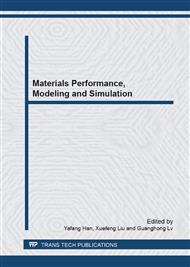[1]
Ding Wenjiang, Science and Technology of Magnesium Alloy, Beijing: Science Press, (2007).
Google Scholar
[2]
S. R. Agnew, J. A. Horton, T. M. Lillo, et al. Enhanced ductility in strongly textured magnesium produced by equal channel angular processing. Scripta Materialia , 2004, 50(3): 377-381.
DOI: 10.1016/j.scriptamat.2003.10.006
Google Scholar
[3]
Lu Guoxiang, Research and Development Prospects of Equal Channel Angular Pressing (ECAP) of Magnesium Alloys Materials Review , 2008, 22(4): 84-87.
Google Scholar
[4]
Minoru Furukawa, Yoshinori Iwahashi, Zenji Horita, et al. Materials Science and Engineering A, 1998, 257(2): 328-332.
Google Scholar
[5]
Dong Hynk Shin, Jong-Jin Pak, Young Kuk Kim, et al. Effect of pressing temperature on microstructure and tensile behavior of low carbon steels processed by equal channel angular pressing. Materials Science and Engineering A, 2002, 325 (1) : 31-37.
DOI: 10.1016/s0921-5093(01)01415-0
Google Scholar
[6]
Furukawa M, Horita Z, Nemoto M, et al. Review processing of metals by equal-channel angular pressing . Journal of Materials Science, 2001, 36: 2835-2843.
Google Scholar
[7]
Chen Kehua, Microstructure and Properties of Al-Mg2Si Alloys after Equal Channel Angular Pressing. Rare Metal Materials and Engineering , 2010, 39(2): 352-355.
Google Scholar
[8]
C.W. Su, B.W. Chua, L. Lu, et al. Properties of severe plastically deformed Mg alloys . Materials Science and Engineering: A, 2005, 402(1): 163-169.
DOI: 10.1016/j.msea.2005.04.035
Google Scholar
[9]
Minoru Furukawa, Yoshinori Iwahashi, Zenji Horita, et al. The shearing characteristics associated with equal-channel angular pressing [J]. Materials Science and Engineering A, 1998, 257(2): 328-332.
DOI: 10.1016/s0921-5093(98)00750-3
Google Scholar
[10]
V.N. Chuvil'deev , T.G. Nieh , M. Yu. Gryaznov , A.N. Sysoev , V.I. Kopylov. Low-temperature superplasticity and internal friction in microcrystalline Mg alloys processed by ECAP. Scripta Materialia 2004 (50): 861–865.
DOI: 10.1016/j.scriptamat.2003.12.003
Google Scholar
[11]
Liu Tianmo,Liu Jianzhong,Microstructure and deformation behavior of dual-directional extruded AZ31 magnesium alloy . The Chinese Journal of Nonferrous Metals[J], 2010(09): 1657-1664.
Google Scholar
[12]
Ding Yeli, Effect of ECAE on Grain Refinement of AZ80A Alloy. Hot Working Technology [J], 2011, 40(3): 89-91.
Google Scholar
[13]
Chen Lijia. Plastic deformation behavior of AZ61 magnesium alloy processed by equal channel angular pressing. Journal of Shenyang University of Technology [J], 2007, 29(1): 21-24.
Google Scholar


